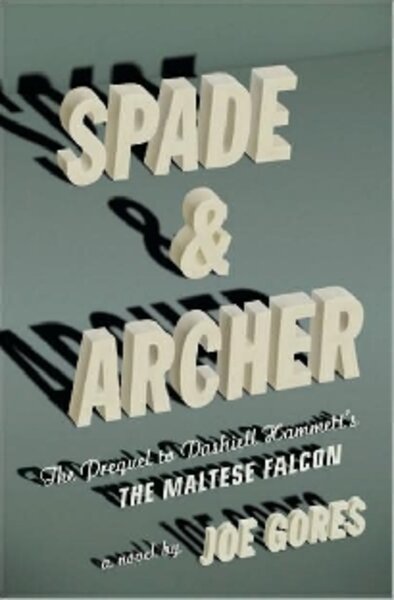Spade and Archer
Loading...
Holmes and Watson. Spenser and Hawk. Shaggy and Scooby. Spade and Archer. Which one of these crime-fighting duos doesn’t belong?
No, actually, it’s not the cartoon. While Scooby has been known to steal Shaggy’s sandwiches, it’s hard to imagine a less felicitous pairing than Sam Spade and Miles Archer. The piggish Archer, as fans of “The Maltese Falcon” know, didn’t last long as Spade’s partner. But why the two of them ever went into business together has been a mystery since Dashiell Hammett’s novel was first published in 1930.
“I’ve been as bad an influence on American literature as anyone I can think of,” Hammett once quipped. The former Pinkerton detective has been called the dean of hardboiled detective novels, and the third movie of “The Maltese Falcon” (the one starring Humphrey Bogart) is considered the first example of film noir. Now, another detective-turned-writer – three-time Edgar Award winner Joe Gores – has written Spade and Archer, a prequel to “The Maltese Falcon,” detailing just how Spade ended up with Archer (and Archer’s wife, for that matter).
“Spade and Archer” is an authorized work, blessed by the Hammett estate, which can be a dicey prospect for readers. Such novels tend to be so tidy and reverential that the creativity gets squeezed right out of them. Happily, Gores’s labor of love is about as far removed from, say, “Scarlett,” (the sequel to “Gone with the Wind”), as fans of either Gores or Hammett could wish.
After a brief opener in Spokane, the action begins in 1921 with Sam partially foiling a gold heist while searching for the runaway son of a rich banker. Sam recovers $50,000 of $125,000 stolen off the ship San Anselmo, and keeps Henny Baker from heading off to the South Seas. (Thanks to a botched operation by police Sergeant Dundy the criminal gets away.) Part 2 takes place in 1925, and Part 3 in 1928. The missing gold, the murderous mastermind behind the heist, and the banker’s son continue to crop up throughout the novel, as does Sam’s future partner, Archer, who, it must be said, doesn’t earn equal billing. He manages to stay alive in this book, but doesn’t appear much more than he did in “Falcon.” Gores, however, manages to give Sam – and readers – several reasons to cordially detest him.
Gores, a noted Hammett scholar, tucks in little asides for fans – he includes famous quotes from “The Maltese Falcon,” such as, “as if someone had taken the lid off life and let you see how it really worked,” and echoes Hammett’s description of Spade, of the yellowish-gray eyes, as looking “rather pleasantly like a blonde satan.” For fun, he even has Spade operate briefly under the alias of “Nick Charles” – the detective in Hammett’s more lighthearted (though just as quotable) “Thin Man” series. And he’s got the staccato dialogue, the San Francisco underworld, the corrupt district attorney, the incompetent bully Dundy, and his far more professional subordinate, Tom Polhaus.
And despite enough action to keep modern fans’ pulses racing, Spade still isn’t likely to come in with pistols blazing: “I think if you need to carry a gun, you’re doing a lousy job as a detective,” he tells his former boss. (In a Q and A included with the afterword, Gores says he never met a private detective who did.)
The chief flaw of the novel: The femmes, they aren’t so fatal. Secretary Effie Perine is smart and adoring, Iva Archer is a boring bombshell, and the rest of the women range from victims to window dressing. (Or both – who says you can’t look your best while getting your throat cut?) The middle section, where we have both a “grieving widow” stylishly dressed in pale blue, and her late husband’s mistress, a gorgeous secretary-turned-stock broker, seems ripe with possibility. The stock broker, Effie’s friend Penny Chiatros, even tries to get Sam on the trail of an ancient antiquity. The Chest of Bergina sounds almost as jewel-encrusted a MacGuffin as the Maltese Falcon. But alas, although the mystery itself is darkly resolved, neither woman seems able to muster enough deviousness to don the mantle noir. Paging Miss Wonderly, ASAP!
Still, why knock a book that incorporates everything from Sun Yat Sen to the works of Robert Louis Stevenson? Gores is actually a superior plotter to Hammett, although he isn’t quite his equal when
it comes to dialogue. (His female characters are especially likely to be laden with clunky exposition.) But that’s not really a criticism: Pound for pound, few writers could toss off as many memorable one-liners as Hammett (aside from William Goldman, of course).
And there is one important exception: Spade. I could hear Bogart’s genial cynicism purring throughout the novel, as the detective offers such nuggets of wisdom as: “Never get between a widow and her husband’s money.” It’s nice that, after all this time, you can still call a Spade a Spade.
Yvonne Zipp regularly reviews fiction for the Monitor.






